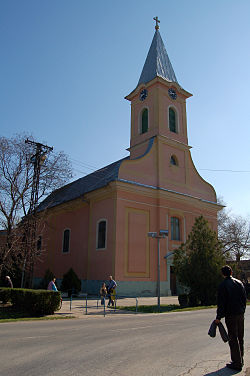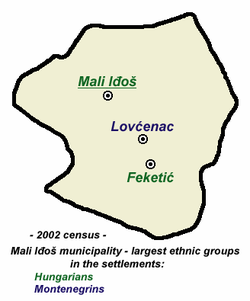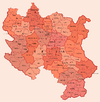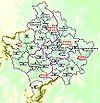- Mali Iđoš
-
Mali Iđoš
Мали Иђош
Kishegyes— Village — Church of Saint Anne in Mali Iđoš 
Coat of armsLocation of the municipality of Mali Iđoš within Serbia Coordinates: 45°43′N 19°40′E / 45.717°N 19.667°E Country Serbia District North Bačka Settlements 3 Government – Mayor Csóré Róbert Area[1] – Municipality 175 km2 (67.6 sq mi) Population (2011 census)[2] – Town 5,465 – Municipality 13,494 Time zone CET (UTC+1) – Summer (DST) CEST (UTC+2) Postal code 24321 Area code +381 24 Car plates SU Not to be confused with Iđoš.Mali Iđoš (Serbian and Montenegrin Cyrillic: Мали Иђош, Hungarian: Kishegyes) is a village and municipality in the North Bačka District of Vojvodina, Serbia. The municipality comprises three local communities and has a population of 13,476, of whom 7,546 (55.92%) are ethnic Hungarians. Mali Iđoš has a population of 5,464, of which Hungarians form an absolute majority of 88.3% or 5,046 people.
Contents
Name
The first part of the name of the village, "mali" ("little" in English), was given in contrast to the village with similar name (Iđoš), which is situated in northern Banat.
Inhabited places
Mali Iđoš municipality includes the following villages:
Demographics (2002)
The total population of the Mali Iđoš municipality is 13,494. By ethnic structure:
- 7,546 Hungarians (55.92%)
- 2,812 Montenegrins (20.84%)
- 2,357 Serbs (17.47%)
- 779 other, undeclared and unknown (5.77%)
By language:
By religion:
- 5,404 Catholics (40.05%)
- 4,730 Eastern Orthodox Christians (35.05%)
- 2,185 Protestants (16.19%)
- 30 Muslims (0.22%)
- 32 other (0.24%)
- 1 agnostic (0.01%)
- 1,080 undeclared (8%)
- 21 atheists (0.16%)
- 11 unknown (0.08%)
Local communities with a Hungarian majority are Mali Iđoš and Feketić. There is one local community with a Montenegrin majority: Lovćenac.
History
The name of Kishegyes was first mentioned in historical documents in 1476. The village became totally destroyed under Turkish occupation in the 16th century. It was repopulated in 1769 by 81 Roman Catholic Hungarian families from Békésszentandrás. The region is extremely well suited for agriculture and the village increased in wealth and population until the 1980s. In the 1990s the local economy was ruined and young people began to emigrate to Hungary. Today the rate of unemployment is appr. 30 percent, and the Agricultural Cooperative and the Commercial Company went bankrupt. After the end of the civil war in Croatia and Bosnia (1995–96) Serbian refugees arrived to Mali Iđoš (Kishegyes). There are no ethnic tensions between native Hungarians and the Serbian refugees.
Historical population of the village
- 1961: 6,860
- 1971: 6,603
- 1981: 6,271
- 1991: 5,803
Sights
The oldest building in Mali Iđoš is the baroque Roman Catholic Church of St. Anne (1788) on the Main Street. There is an old Calvary, the obelisk of the Battle of Kishegyes and the ruins of the Pecze Mansion. The natural attractions are the River Krivaja and the imposing loessal walls of the Hills of Telečka.
Famous people
- The Hungarian singer Magdolna Rúzsa grew up in Mali Iđoš. She won Megasztár, Hungary's version of Pop Idol in 2006 and represented Hungary at the Eurovision Song Contest 2007 in Helsinki, Finland.
- Istvan Dudas is a former Serbian professional footballer, who currently works as Goalkeeper coach for R.O.C. de Charleroi-Marchienne.[3]
See also
- List of places in Serbia
- List of cities, towns and villages in Vojvodina
References
- ^ "Municipalities of Serbia, 2006". Statistical Office of Serbia. http://webrzs.stat.gov.rs/axd/en/Zip/OG2006webE.zip. Retrieved 2010-11-28.
- ^ "2011 Census of Population, Households and Dwellings in the Republic of Serbia – FIRST RESULTS". Bulletin (Statistical Office of the Republic of Serbia) 540. 2011. ISSN 0354-3641. http://media.popis2011.stat.rs/2011/prvi_rezultati.pdf. Retrieved 2011-11-21.
- ^ Le Noyau : Istvan Dudas (T3) - ROCCM
- Slobodan Ćurčić, Broj stanovnika Vojvodine, Novi Sad, 1996.
External links
- Non-official website
- History of Mali Iđoš (Hungarian)
Cities, towns and villages in the North Bačka District Subotica: Bajmok • Bački Vinogradi • Bačko Dušanovo • Bikovo • Višnjevac • Gornji Tavankut • Donji Tavankut • Đurđin • Kelebija • Ljutovo • Mala Bosna • Mišićevo • Novi Žednik • Palić • Stari Žednik • Hajdukovo • Čantavir • Šupljak
Bačka Topola: Bagremovo • Bajša • Bački Sokolac • Bogaraš • Gornja Rogatica • Gunaroš • Zobnatica • Kavilo • Karađorđevo • Krivaja • Mali Beograd • Mićunovo • Novo Orahovo • Njegoševo • Obornjača • Tomislavci • Panonija • Pačir • Pobeda • Svetićevo • Srednji Salaš • Stara Moravica
(*) bold are municipalities
Coordinates: 45°42′25″N 19°39′52″E / 45.70694°N 19.66444°E
Categories:- Places in Bačka
- Populated places in Vojvodina
- Municipalities of Vojvodina
Wikimedia Foundation. 2010.








